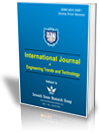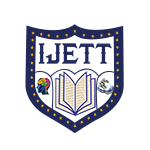Development of Novel Hexanal Nano-fibre Matrix by Electrospinning for Shelf-life Extension of Mango Fruits
Development of Novel Hexanal Nano-fibre Matrix by Electrospinning for Shelf-life Extension of Mango Fruits |
||
 |
 |
|
| © 2025 by IJETT Journal | ||
| Volume-73 Issue-3 |
||
| Year of Publication : 2025 | ||
| Author : Kwaghgba Elijah Gbabe, Mike Ojotu Eke, Dinnah Ahure, Sylvester Obaike Adejo, Michael Ayodele Omodara, Kizhaera Sevathapandian Subramanian, M. Prasanthrajan and Jagatheesan Mohanraj |
||
| DOI : 10.14445/22315381/IJETT-V73I3P132 | ||
How to Cite?
Kwaghgba Elijah Gbabe, Mike Ojotu Eke, Dinnah Ahure, Sylvester Obaike Adejo, Michael Ayodele Omodara, Kizhaera Sevathapandian Subramanian, M. Prasanthrajan and Jagatheesan Mohanraj, "Development of Novel Hexanal Nano-fibre Matrix by Electrospinning for Shelf-life Extension of Mango Fruits," International Journal of Engineering Trends and Technology, vol. 73, no. 3, pp. 461-472, 2025. Crossref, https://doi.org/10.14445/22315381/IJETT-V73I3P132
Abstract
The current work used electrospinning to create a unique hexanal nano-fibre matrix for the noncontact packaging of mango fruits to improve their shelf life during storage and transportation. Thus, the problem of colour spots is overcome, and the vaporisation of hexanal molecules on the surface of fruits is reduced during postharvest treatment. Hexanal release from the nano-fibre matrix was confirmed using gas chromatography-mass spectrometry. The scanning electron microscope exposed nanowires with diameters ranging from 195.5 to 345.8 nm. The FT-IR spectra revealed the distinctive peak of hexanal in the wavenumber region of 1894-1147cm-1. Applying the hexanal nano-fibre matrix to green matured mango fruits in ambient environments resulted in a 14-day shelf-life extension. In comparison, the control samples remained fresh for only 6 days. The effect of the hexanal nano-fibre on mango sensory qualities revealed that freshly picked mangoes scored higher values in appearance, color, texture, flavour, and overall acceptability than treated fruits. The treated fruits had better quality qualities than the control fruits, such as decreased physiological weight loss, increased firmness, lower percentage decay, higher pH, and better color.
Keywords
Electrospinning, Food security, Hexanal, Postharvest loss, Shelf life.
References
[1] A.C. Matheyambath et al., Encyclopedia of Food and Health, Eds. BC Paul, pp. 641-645, 2016.
[Google Scholar]
[2] Zinash Delebo Osunde, “Effects of Treatments and Dry Methods on Some Qualities of Dried Mango (Mangifera Indica) Fruits,” Agricultural Engineering International: CIGR Journal, vol. 19, no. 1, pp. 187-194, 2017.
[Google Scholar] [Publisher Link]
[3] Elhadi M. Yahia et al., “Their Contribution of Mango (Mangifera Indica) Fruits to Human Nutrition and Health,” Arabian Journal of Chemistry, vol. 16, no. 7, pp. 1-27, 2023.
[CrossRef] [Google Scholar] [Publisher Link]
[4] Kanmani Venkatachalam et al., “Post-Harvest Dip of Enhanced Freshness Formulation to Extend the Shelf Life of Banana (Musa Acuminata CV, Grand Naine) in India,” Tropical Agriculture, vol. 95, no. 1, pp. 1-13, 2018.
[Google Scholar] [Publisher Link]
[5] Peninah Mueni Yumbya et al., “Efficacy of Hexanal Applications on the Post-Harvest Shelf Life and Quality of Banana Fruit (Musa Acuminata) in Kenya,” Tropical Agriculture, vol. 95, no. s1, pp. 1-22, 2018.
[Google Scholar] [Publisher Link]
[6] Sandhya, “Modified Atmosphere Packaging of Fresh Produce: Current Status and Future Needs,” LWT:Food Science and Technology, vol. 43, no. 3, pp. 381-392, 2010.
[CrossRef] [Google Scholar] [Publisher Link]
[7] Adel A. Kader, “A Perspective on Postharvest Horticulture (1978–2003),” HortScience, vol. 38, no. 5, pp. 1004-1008, 2003.
[CrossRef] [Google Scholar] [Publisher Link]
[8] Wang Juxia et al., “Study on Tensile Mechanical Property and Microstructure of Fruit and Vegetable Peels,” INMATEH-Agricultural Engineering, vol. 59, no. 3, pp. 227-236, 2013.
[CrossRef] [Google Scholar] [Publisher Link]
[9] G.N. Ashitha, C. Sunny Anjaly, and R. Nisha, “Effect of Pre-Harvest and Post-Harvest Hexanal Treatments on Fruits and Vegetables: A Review,” Agricultural Reviews, vol. 41, no. 2, pp. 124-131, 2020.
[CrossRef] [Google Scholar] [Publisher Link]
[10] Anna Balteril et al., “Evaluation of Post-Harvest Losses and Shelf-life of Fresh Mango (Mangifera Indica L) in Eastern Zone of Tanzania Evaluation of Post-Harvest Losses and Shelf Life of Fresh,” International Journal of Fruit Science, vol. 20, no. 4, pp. 855-870, 2020.
[CrossRef] [Google Scholar] [Publisher Link]
[11] Gopinadhan Paliyath et al., “Inhibition of Phospholipase D,” U.S Patent 6514914B1, pp. 1-35, 2003.
[Google Scholar] [Publisher Link]
[12] Gopinadhan Paliyath et al., “Effect of Processing Conditions on Phospholipase D Activity of Corn Kernel Subcellular Fractions,” Journal of Agricultural and Food Chemistry, vol. 47, no. 7, pp. 2579-2588, 1999.
[CrossRef] [Google Scholar] [Publisher Link]
[13] Mohini Sharma et al., “Hexanal and 1-MCP Treatments for Enhancing the Shelf Life and Quality of Sweet Cherry (Prunusavium L.),” Scientia Horticulturae, vol. 125, no. 3, pp. 239-247, 2010.
[CrossRef] [Google Scholar] [Publisher Link]
[14] W. El Kayal et al., “Effect of Preharvest Application of Hexanal and Growth Regulators in Enhancing Shelf-life and Regulation of Membrane Associated Genes in Strawberry,” Canadian Journal of Plant Science, vol. 97, no. 6, pp. 1109-1120, 2017.
[CrossRef] [Google Scholar] [Publisher Link]
[15] Amer Cheema et al., “Postharvest Biology and Technology Improving Quality of Greenhouse Tomato (Solanum Lycopersicum L) by Pre- and Postharvest Applications of Hexanal-Containing Formulations,” Postharvest Biology and Technology, vol. 95, pp. 13-19, 2014.
[CrossRef] [Google Scholar] [Publisher Link]
[16] A.M. Wani et al., “Effect of Gamma-Irradiation and Refrigerated Storage on the Improvement of Quality and Shelf Life of Pear (Pyrus Communis L., Cv. Bartlett/William),” Radiation Physics and Chemistry, vol. 77, no. 8, pp. 983-989, 2008.
[CrossRef] [Google Scholar] [Publisher Link]
[17] “Official Methods of Analysis of the Association of Official Analytical Chemists,” Association of Official Analytical Chemists, vol. 11, 2000.
[Google Scholar]
[18] Malkeet S. Padda et al., “Methods to Analyze Physico-Chemical Changes during Mango Ripening: A Multivariate Approach,” Postharvest Biology and Technology, vol. 62, no. 3, pp. 267-274, 2011.
[CrossRef] [Google Scholar] [Publisher Link]
[19] M.O. Iwe, Handbook of Sensory Methods and Analysis, Rojoint Communication Science Ltd., Enugu, Nigeria, 2010.
[Google Scholar]
[20] Fatma Kayaci et al., “Functional Electrospun Polymeric Nanofibers Incorporating Geraniol-Cyclodextrin Inclusion Complexes,” Food Research International, vol. 62, pp. 424-431, 2014.
[CrossRef] [Google Scholar] [Publisher Link]
[21] Yibo Zhang et al., “Encapsulation of Thymol in Biodegradable Nanofiber via Coaxial Electrospinning and Applications in Fruit Preservation,” Journal of Agricultural Food Chemistry, vol. 67, no. 6, pp. 1736-1741, 2019.
[CrossRef] [Google Scholar] [Publisher Link]
[22] Juxia Wang et al., “Study on Tensile Mechanical Property and Microstructure of Fruit and Vegetable Peels,” INMATEH-Agricultural Engineering, vol. 59, no. 3, pp. 227-236, 2019.
[Google Scholar] [Publisher Link]
[23] Hongyang Ma et al., “Fabrication and Characterization of Cellulose Nanofiber Based Thin-Film Nanofibrous Composite Membranes,” Journal of Membrane Science, vol. 454, pp. 272-282, 2014.
[CrossRef] [Google Scholar] [Publisher Link]
[24] A.R. Jabur, M.A. Najim, and Sh.A. Abd Al-Rahman, “Effect of Flow Rate on some Physical Properties of Different Polymeric Solutions,” IOP Conference Series: Journal of Physics, pp. 1-7, 2018.
[CrossRef] [Google Scholar] [Publisher Link]
[25] Ping Shao, “Fabrication and Characterization of Tea Polyphenols Loaded Pullulan-CMC Electrospun Nanofiber for Fruit Preservation,” International Journal of Biological Macromolecules, vol. 107, no. B, pp. 1908-1914, 2018.
[CrossRef] [Google Scholar] [Publisher Link]
[26] Carlos Alberto Fuenmayor et al., “Encapsulation of R-(+)-Limonene in Edible Electrospun Nanofibers,” Chemical Engineering Transactions, vol. 32, pp. 1771-1776, 2013.
[CrossRef] [Google Scholar] [Publisher Link]
[27] J.M. Deitzel et al., “Effect of Processing Variables on the Morphology of Electrospun Nano Fibers,” Polymer, vol. 42, no. 1, 261-272, 2001.
[CrossRef] [Google Scholar] [Publisher Link]
[28] Asli Celebioglu, and Tamer Uyar, “Green and One-step Synthesis of Gold Nanoparticles Incorporated into Electrospun Cyclodextrin Nanofibers,” RSC Advances, vol. 3, no. 26, pp. 10197-10201, 2013.
[CrossRef] [Google Scholar] [Publisher Link]
[29] N. Amreena Jan et al., “Nano-Fiber Enabled Regulated Release of Hexanal Vapour and Its Impact on the Shelf Life of Mango Fruits,” Polymer Bulletin, vol. 80, pp. 865-881, 2023.
[CrossRef] [Google Scholar] [Publisher Link]
[30] Pradeep damodaran, Kizhaeral S. Subramanian, and Kannan Malaichamy, “Development and Characterization of Cellulosic Nano Fibre Matrix Loaded with Hexanal,” International Journal of Chemical Studies, vol. 7, no. 4, pp. 71-74, 2019.
[Google Scholar] [Publisher Link]
[31] Syndhiya Ranjan et al., “Effect of Hexanal Loaded Electrospun Fiber in Fruit Packaging to Enhance the Post-Harvest Quality of Peach,” Food Packaging and Shelf Life, vol. 23, 2020.
[CrossRef] [Google Scholar] [Publisher Link]
[32] Kavirajaa Pandian Sambasevam et al., “Synthesis and Characterization of the Inclusion Complex of β-cyclodextrin and Azomethine,” International Journal of Molecular Science, vol. 14, no. 2, pp. 3671-3682, 2013.
[CrossRef] [Google Scholar] [Publisher Link]
[33] Hanseul Kim et al., “Controlled Self-Release of ClO2 as an Encapsulated Antimicrobial Agent for Smart Packaging,” Innovation Food Science Emergency Technology, vol. 74, 2021.
[CrossRef] [Google Scholar] [Publisher Link]
[34] Pothuraja Anusuya et al., “Pre-Harvest Sprays of Hexanal Formulation for Extending Retention and Shelf-Life of Mango (Mangifera Indica L.) Fruits,” Scientia Horticulturae, vol. 211, pp. 231-240, 2016.
[CrossRef] [Google Scholar] [Publisher Link]
[35] M. Jincy et al., “Inhibition of Phospholipase D Enzyme Activity through Hexanal Leads to Delayed Mango (Mangifera Indica L.) Fruit Ripening through Changes in Oxidants and Antioxidant Enzymes Activity,” Scientia Horticulturae, vol. 218, pp. 316-325, 2017.
[CrossRef] [Google Scholar] [Publisher Link]
[36] Jaspa Samwel et al., “Pre-Harvest Field Application of Enhanced Freshness Formulation Reduces Yield Loss in Orange,” Chemical and Biological Technologies in Agriculture, vol. 7, no. 1, 2020.
[CrossRef] [Google Scholar] [Publisher Link]
[37] K.S. Gill et al., Enhancing Postharvest Shelf-life and Quality of Guava (PsidiumguajavaL.) cv. Allahabad Safedaby Pre-harvest Application of Hexanal Containing Aqueous Formulation,” Postharvest Biology and Technology, vol. 112, pp. 224-232, 2016.
[CrossRef] [Google Scholar] [Publisher Link]
[38] Kirandeep Kaur, Gagandeep Kaur, and Jaswinder Singh Brar, “Pre-Harvest Application of Hexanal Formulations for Improving Post-Harvest Life and Quality of Mango (Mangifera Indica L.) cv. Dashehari,” Journal of Food Science and Technology, vol. 57, pp. 4257-4264, 2020.
[CrossRef] [Google Scholar] [Publisher Link]
[39] My Dong Lieu, and Thi Kim Thuy Dang, “Improvement of Shelf-Life of Mangoes by Chitosan Coating Enriched with Cinnamon Oil Dissolved in Tween 80 Combined with Ethanol,” Food Bioscience, vol. 44, no. B, 2021.
[CrossRef] [Google Scholar] [Publisher Link]
[40] Roberta Passafiume et al., “Fresh-Cut Mangoes: How to Increase Shelf Life by Using Neem Oil Edible Coating,” Coatings, vol. 12, no. 5, pp. 1-23, 2012.
[CrossRef] [Google Scholar] [Publisher Link]
[41] Apratim Jash, Gopinadhan Paliyath, and Loong-Tak Lim, “Activated Release of Bioactive Aldehydes from their Precursors Embedded in Electrospun Poly (Lactic Acid) Nonwovens,” RSC Advances, vol. 8, no. 36, pp. 19930-19938, 2018.
[CrossRef] [Google Scholar] [Publisher Link]
[42] Zeynep Aytac et al., “Release and Antibacterial Activity of Allylisothiocyanate/β-Cyclodextrin Complex Encapsulated in Electrospun Nano-Fibres,” Colloids and Surfaces B: Biointerfaces, vol. 120, pp. 125-131, 2014.
[CrossRef] [Google Scholar] [Publisher Link]

